
Colorado is a beautiful state with many mountain peaks, and hiking trails to enjoy. Although there is a lot of beauty to admire, it’s also important to stay vigilant. Some of the prettiest flowers and plants can lead to deadly or uncomfortable situations! Before you pick an unknown plant on your next walk in Colorado, read along and think twice. Listed below are 7 poisonous plants in Colorado you should avoid.
1. Western Water Hemlock
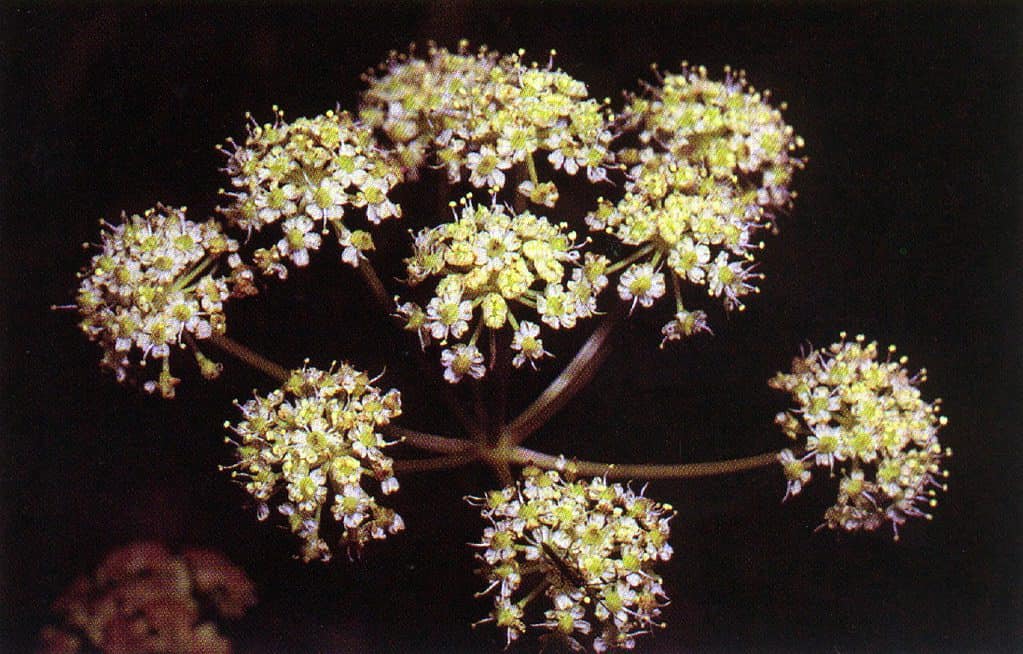
The western water hemlock is the most poisonous plant on the North American continent.
©Robert H. Mohlenbrock / Public Domain – License
Western water hemlock belongs to the Apiaceae family. Its scientific name is Cicuta douglasii. Another name for this poisonous, and potentially deadly plant, is poison parsley. It is very common in British Colombia but is found all across North America, including Colorado. This perennial plant has tall steps with purple spots reaching up to 6.5 feet. The leaves are long with jagged edges.
These plants are best known for their beautiful clustering flowers. Don’t let their beauty fool you though, this plant is very toxic. Western water hemlocks produce small white flowers in spring and summer. They are common throughout the state but grow best in wet conditions near lakes, ponds, rivers, and marshes. You can also find these plants in wet pastures, which is extremely dangerous for animals. The roots of western water hemlock produce cicutoxin, making it one of the most toxic plants in the country. The toxin is a yellowish liquid that attacks the central nervous system. When ingested, even in small parts, this plant can cause nervousness, dizziness, tremors, and weakness, eventually leading to death. When consuming a lethal dose, death occurs quickly, in about 15 minutes.
2. Poison Ivy
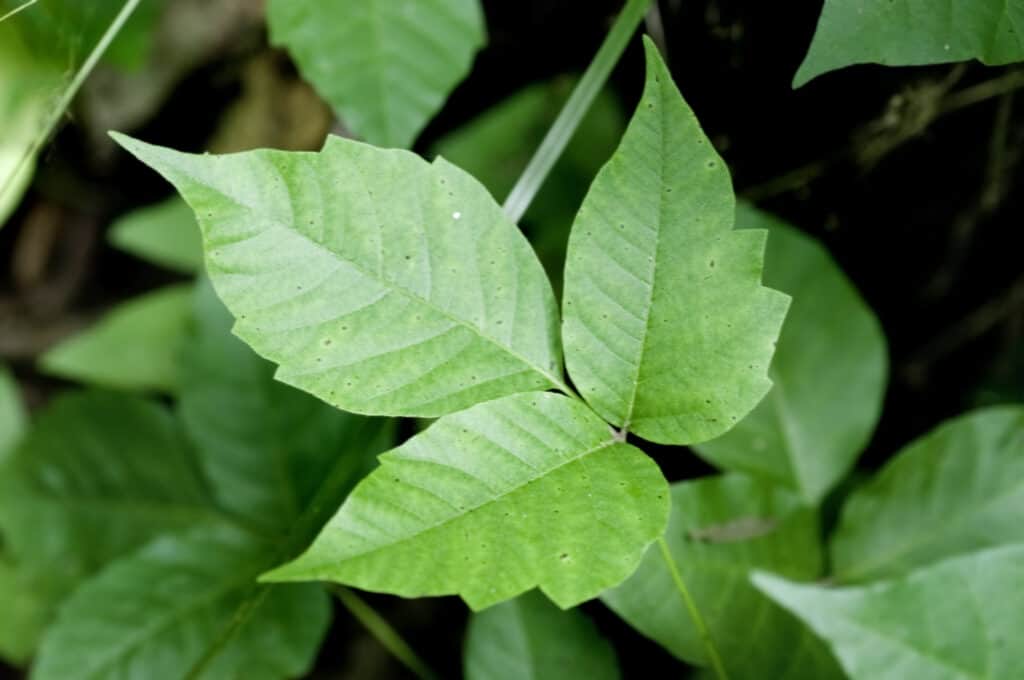
Poison ivy is one of many poisonous plants in Colorado, however, it’s not abundant.
©Tim Mainiero/Shutterstock.com
Poison ivy is one of the most common allergenic plants in North America. Although poisonous and uncomfortable, it’s rarely deadly. Until recently, poison ivy was thought to be one species. Now, three separate species are recognized including Toxicodendron orientale, Toxicodendron radicans, and Toxicodendron rydbergii. These three species though have similar appearances.
The most common poison ivy species in Colorado is Toxicodendron rydbergii, also known as western poison ivy. Although this species is the most common in Colorado, it’s not abundant. Still, always look out for a creeping vine or shrub with green leaves growing in threes. One place you can find this poisonous plant in Colorado is Boulder County.
So, what happens if you touch poison ivy? Everyone reacts differently. About 25% of people who come in contact with poison ivy don’t have an allergic reaction, while a small number of people go into anaphylaxis. Blisters and redness appear when in contact with poison ivy. If you think you are having an allergic reaction, immediately wash the affected area with cold water and soap. With treatment, the rash can remain for about 1 to 4 weeks.
3. Castor Bean
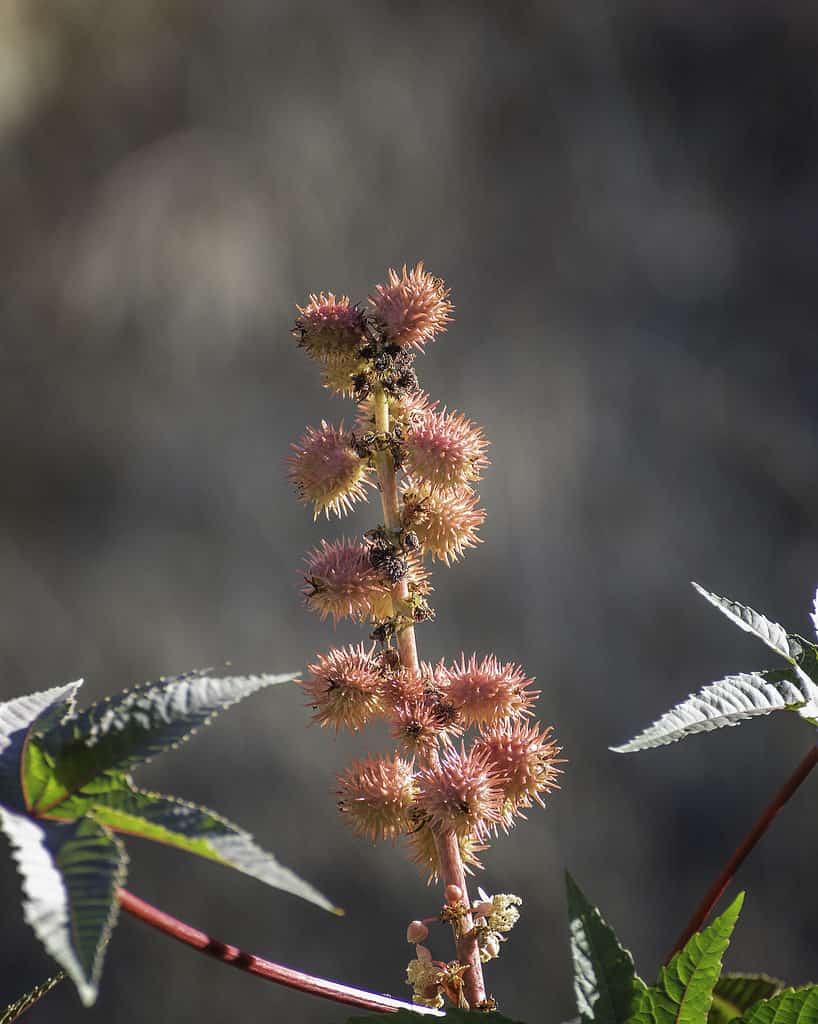
Castor bean plants are native to parts of
Africa
, but are common in North America and are poisonous plants in Colorado.
©iStock.com/GDMatt66
Castor bean, also known as the castor oil plant, is a poisonous plant in the Euphorbiaceae family. It’s native to parts of Africa but is found all over the world. In the southern United States, castor bean plants grow and spread like a weed. Sometimes though, these plants are grown as beautiful ornamentals.
In the right conditions, this plant can grow as tall as a small tree. It’s an annual plant with large colorful leaves. Interestingly, the leaves begin reddish-purple and are green as they mature. This plant produces fruit in the shape of a capsule with brown mottled seeds.
Castor bean plants are dangerous when consumed. The seeds contain a high amount of ricinoleic acid. The leaves are also poisonous, but the amount of toxins is generally lower. Instead, death is more common in animals and humans that consume castor seeds. Symptoms include diarrhea, tremors, muscle weakness, and severe vomiting.
4. Larkspur

Another poisonous plant in Colorado is the larkspur.
©iStock.com/AndreaAstes
The next poisonous plant in Colorado on our list is the larkspur, which can refer to multiple plants in the Delphinium genus. This genus contains over 300 annual and perennial plants. One of the most common larkspur in Colorado is the Delphinium elatum. Other names for this species are alpine delphinium and candle larkspur. This beautiful flowering plant is native to parts of Asia and Europe. It grows up to 5.9 feet tall and produces multiple spikes of blue, white, pink, cream, or purple flowers.
Although this plant isn’t extremely poisonous and rarely causes death, it can lead to discomfort. If you see this beautiful plant growing and want to touch it, always wear gloves. Ingesting this toxic plant can lead to severe discomfort. You can easily find this plant in woodlands, clearings, and near rivers.
5. Locoweed
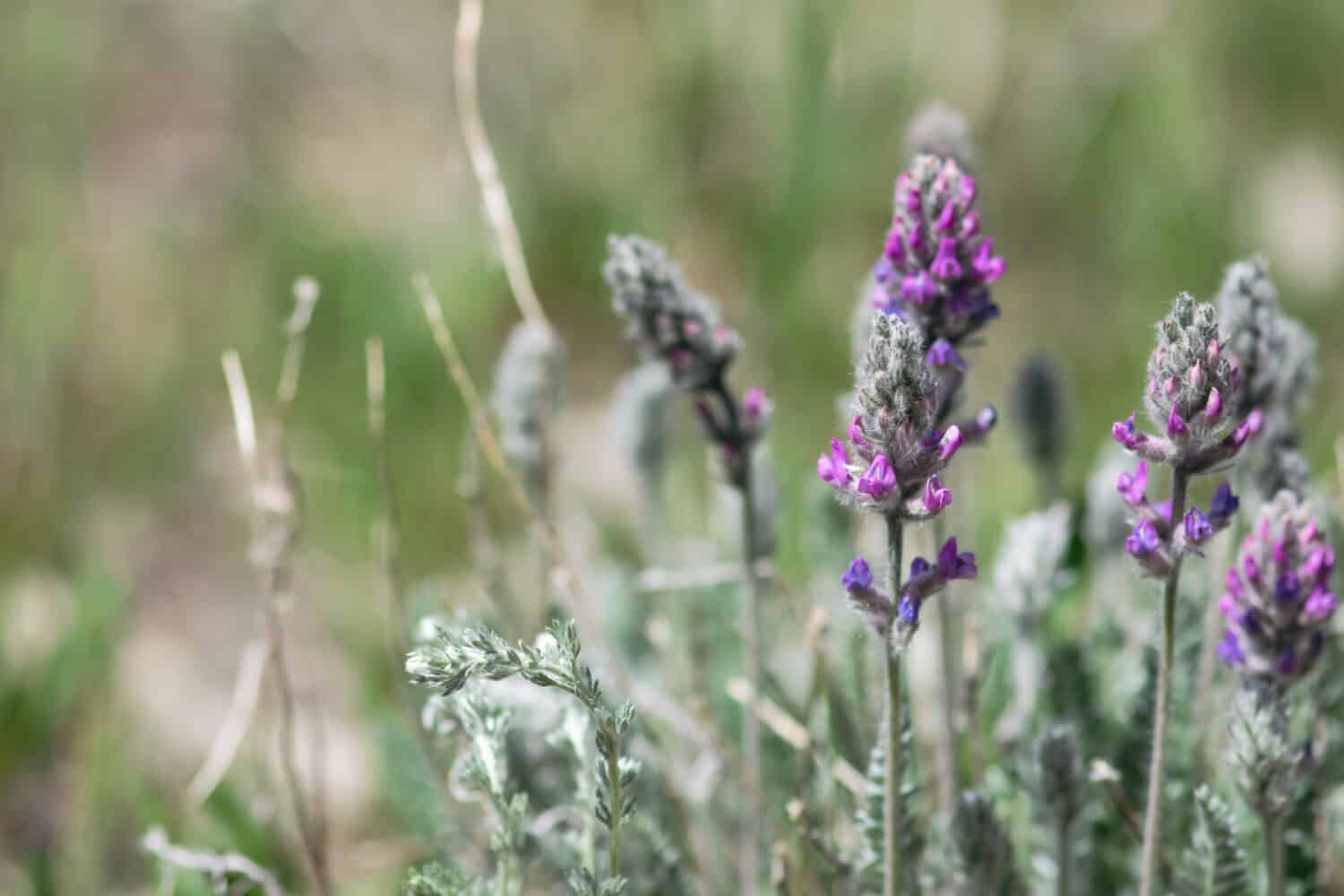
Rocky Mountain locoweeds are native to Colorado.
©Katie Kirkland/Shutterstock.com
Have you ever heard of Rocky Mountain Locoweed? It’s a quick-growing poisonous plant in Colorado. Other names for this locoweed are Colorado locoweed, Lambert’s crazy weed, and purple locoweed. The scientific name for this plant species is Oxytropis lambertii. It’s native to Colorado and is common in mountains and foothills.
Apart from Colorado, this beautiful but toxic plant also grows in central Canada, Texas, Montana, and Arizona. It’s easy to spot and identify as the plant produces bright pink, red, or purple flowers. This plant is also part of the legume family and produces legume pods.
Like other locoweeds, this plant is very toxic to grazing animals and livestock. It’s dangerous when grown too close to animals like horses and cows. The toxin that causes the fatalities and symptoms is swainsonine.
6. African Rue
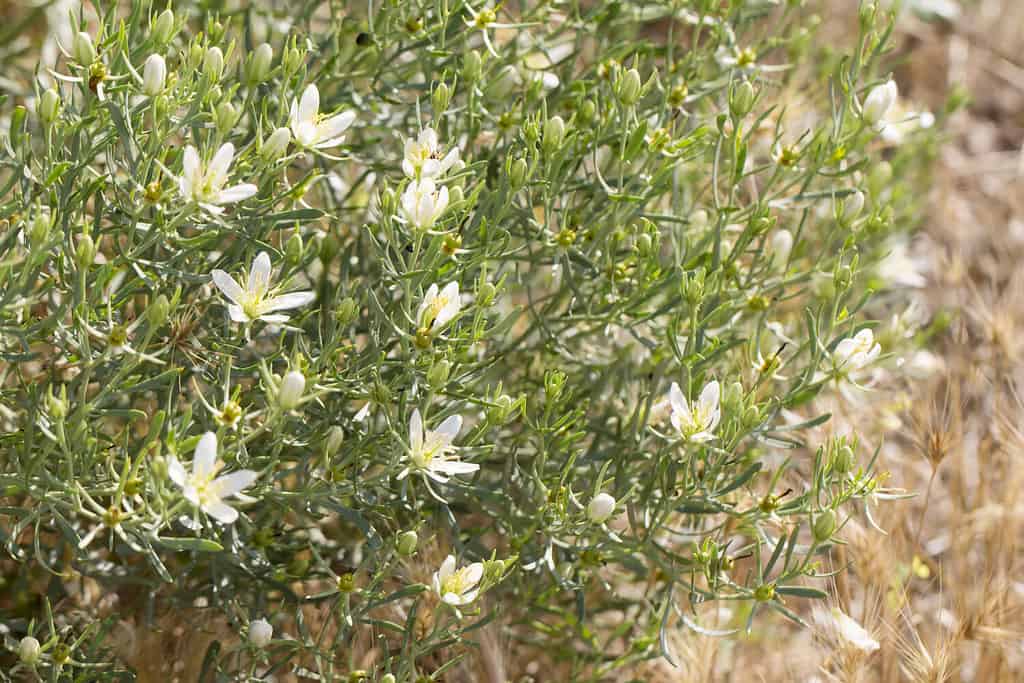
African rue is an invasive poisonous plant in Colorado, native to many parts of Europe, Asia, and Africa.
©Vitolga/Shutterstock.com
African rue in an invasive poisonous plant in Colorado. Its scientific name is Peganum harmala. This plant Athough is called many names, including wild rue, Syrian rue, and harmel. The plant belongs to the family Nitrariaceae.
Although found in Colorado and other states in the U.S., this plant is native to many places in Africa, Europe, and Asia. Some countries within its native range are Spain, Morocco, China, Serbia, Yemen, Iran, Turkey, and Pakistan. This plant is very invasive in some western states in the U.S., but in other countries, doesn’t negatively impact the environment. For example, although this plant is invasive in Mexico, Ukraine, South Africa, and France, there has been no recorded negative impact.
The problem with African rue is that it’s a harmful weed. It grows and spreads quickly, and can cause harm to livestock because of its toxin. Animals that consume this plant can develop fertility issues.
7. Silvery Lupine

Consuming silvery lupine can cause discomfort. However, ingesting large amounts can be fatal.
©Nadya So/Shutterstock.com
Last but not least on our list of 7 poisonous plants in Colorado is the silvery lupine, also known as Lupinus argenteus. This plant is native to most of western North America, including parts of Canada and the U.S. This plant thrives in many habitats, but can be found in mountain ranges, forests, and grasslands. It easily stands up to 4.9 feet tall. These plants produce clusters of vibrant flowers that are important for many insects, including butterflies. This plant is a food source for hummingbirds.
As beautiful as this flowering plant is though, it’s also toxic. It’s especially dangerous for livestock and pets. Many parts of the plant contain the teratogenic alkaloid anagyrine. This toxin is most common in the plant’s pods, seeds, and young leaves. Ingesting large amounts can prove to be fatal. Consuming small amounts causes discomfort.
Summary of 7 Poisonous Plants in Colorado You Should Avoid
| Plant | Danger | |
|---|---|---|
| 1 | Western Water Hemlock | When ingested can cause nervousness, dizziness, tremors, and weakness, eventually leading to death |
| 2 | Poison Ivy | Causes blisters and redness and allergic reactions |
| 3 | Castor Bean | Causes diarrhea, tremors, muscle weakness, and severe vomiting – consuming seeds can cause death |
| 4 | Larkspur | Ingesting can lead to severe discomfort |
| 5 | Locoweed | Very toxic to grazing animals |
| 6 | African Rue | Can cause infertility in animals that consume it |
| 7 | Silvery Lupine | Consuming large amounts can cause death – especially to pets |
The photo featured at the top of this post is © iStock.com/OlyaSolodenko
Thank you for reading! Have some feedback for us? Contact the AZ Animals editorial team.






